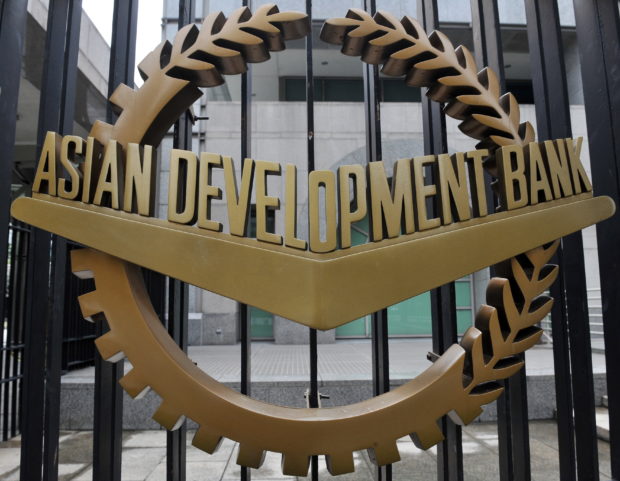ADB: PH output gap highest in Asean, inflicts deep labor wounds

A picture shows the logo of the Asian Development Bank (ADB) displayed outside its headquarters in Manila on September 2, 2010. Photo by TED ALJIBE / AFP
MANILA, Philippines—The Philippines’ output gap, or actual economic growth three years into the COVID-19 pandemic and its pre-pandemic potential, remains to be the highest in Asean, resulting in labor market scarring, the Asian Development Bank (ADB) said on Wednesday (March 16).
Estimates presented at a press briefing by ADB Southeast Asia department senior economist James Villafuerte showed that despite the better-than-expected 5.6-percent gross domestic product (GDP) growth posted by the Philippines last year, its actual output was 15.7-percent below what would have been GDP if the pandemic did not happen.
Even if the Philippine economy grew 6 percent this year as projected by the ADB, the output gap remained a sizable 16 percent. These gaps between the Philippines’ growth rates amid recovery from the pandemic-induced slump and pre-pandemic potential were the biggest in Asean.
Villafuerte said it did not help that the Philippines had among the fastest average growth rate during the decade before the pandemic—6.4 percent—such that the 9.6-percent GDP contraction in 2020, at the height of the longest and most stringent lockdowns imposed to contain COVID-19, resulted in the largest output gap in the region.
What appears to be strong growth rates to be posted by the Philippines following its worst annual recession in 2020 would reflect base effects and mask the pandemic’s scarring effects, Villafuerte said.
Amid the Ukraine-Russia war, Villafuerte and ADB director-general for Southeast Asia Ramesh Subramaniam both expect modest impact on Asean economies, although already skyrocketing oil and commodity prices would jack up inflation across the region, they said.
In a report on Wednesday, debt watcher Moody’s Investors Service said that “inflationary pressures are likely to build faster in economies where fuel and electricity prices have a heavier weight in consumption baskets, or where imported fuel is predominant: These include India, Laos, Pakistan, the Philippines, Sri Lanka and Vietnam.”
“Similarly, pressure on governments to raise subsidies will increase, leading to greater fiscal strains,” Moody’s said. The Philippine government will distribute P6.1 billion in fuel subsidies and discounts this month and next month, on top of P33.1-billion in cash aid to the bottom 50-percent income households to mitigate the impact of expensive oil on vulnerable sectors.
On the flip side, Villafuerte said high oil costs could fast-track the shift to greener energy and economic recoveries in Asean.
ADB president Masatsugu Asakawa, in a speech at the Manila-based lender’s Southeast Asia development symposium, noted that the ADB’s energy transition mechanism (ETM) being piloted in the Philippines and Indonesia would “help Southeast Asia move toward a low-carbon future.” The ETM will finance retirement of coal-fired plants and their replacement by clean energy sources.
However, the ADB’s “Southeast Asia Rising from the Pandemic” report released on Wednesday said that “in the Philippines, the COVID-19 pandemic triggered a massive disruption of the labor market, which could leave an enduring impact.”
“Although the unemployment rate has eased since the onset of the pandemic, it remains higher than in 2019 and many workers are working fewer hours,” the ADB said.
A separate report of the state planning agency National Economic and Development Authority (Neda) showed that the Philippines’ 6.6 percent unemployment rate in December 2021 was only better than India’s 7.9 percent among emerging Asian economies.
By the end of last year, Vietnam had a lower jobless rate of 3.6 percent; China, 3.9 percent; Malaysia, 4.3 percent; and Indonesia, 6.5 percent.
In 2021, the national jobless rate averaged 7.8 percent, within the government’s adjusted 7 to 9 percent target due to the pandemic, and lower than the 15-year high of 10.3 percent in 2020.
“There was a rebound in terms of employment levels, from a net loss of 2.6 million in 2020 to a net employment gain of 4.6 million in 2021,” Neda said.
Neda said the Philippines’ jobless rate was “expected to further improve as growth prospects remain encouraging given the more targeted COVID-19 containment measures that will allow for the gradual and safe reopening of the economy.”
However, the ADB report said that the prolonged pandemic scarred the Philippine labor market, as shown by the slow return of jobs as well as mismatch between returning employment opportunities and workers’ skills.
Villafuerte said the Philippines’ unemployment rate remained above the long-term trend, as many workers shifted to informal, precarious jobs.
The youth, prime aged, women and low-skilled workers were the most badly hit by this labor marker scarring, Villafuerte added.
“The pandemic has triggered a large reallocation of jobs across sectors. The hardest-hit sectors are those dependent on personal contact, such as accommodation, food services, transportation, and recreational services. This change in employment composition may persist,” the ADB said.
“Companies have also been rapidly adopting digital technologies in their business models, further increasing demand for higher skills. These developments are likely to increase the mismatch between new skills demanded by employers and those skills possessed by displaced workers,” it said.
“The longer displaced workers and new labor market entrants remain unemployed, the more likely they will become less employable because of lost skills,” ADB added.
The ADB urged the Philippines to address its pandemic-induced labor market scarring through skills upgrading, apprenticeship programs, digitalization, as well as unemployment insurance schemes.
“Strengthening labor market programs will be critical to help workers transition to new jobs,” ADB said.
